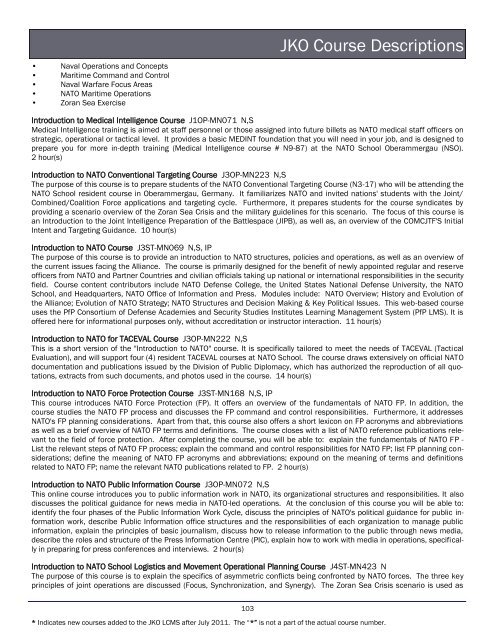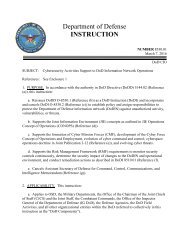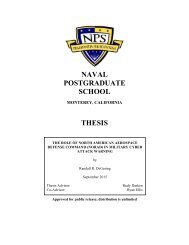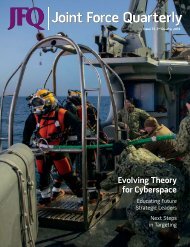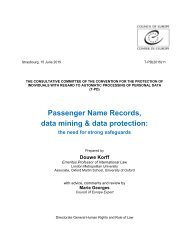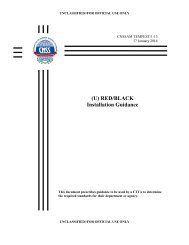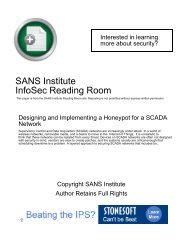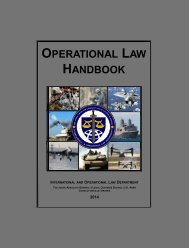jko-catalog-sep-2012
jko-catalog-sep-2012
jko-catalog-sep-2012
You also want an ePaper? Increase the reach of your titles
YUMPU automatically turns print PDFs into web optimized ePapers that Google loves.
• Naval Operations and Concepts<br />
• Maritime Command and Control<br />
• Naval Warfare Focus Areas<br />
• NATO Maritime Operations<br />
• Zoran Sea Exercise<br />
* Indicates new courses added to the JKO LCMS after July 2011. The “*” is not a part of the actual course number.<br />
103<br />
JKO Course Descriptions<br />
Introduction to Medical Intelligence Course J1OP-MN071 N,S<br />
Medical Intelligence training is aimed at staff personnel or those assigned into future billets as NATO medical staff officers on<br />
strategic, operational or tactical level. It provides a basic MEDINT foundation that you will need in your job, and is designed to<br />
prepare you for more in-depth training (Medical Intelligence course # N9-87) at the NATO School Oberammergau (NSO).<br />
2 hour(s)<br />
Introduction to NATO Conventional Targeting Course J3OP-MN223 N,S<br />
The purpose of this course is to prepare students of the NATO Conventional Targeting Course (N3-17) who will be attending the<br />
NATO School resident course in Oberammergau, Germany. It familiarizes NATO and invited nations' students with the Joint/<br />
Combined/Coalition Force applications and targeting cycle. Furthermore, it prepares students for the course syndicates by<br />
providing a scenario overview of the Zoran Sea Crisis and the military guidelines for this scenario. The focus of this course is<br />
an Introduction to the Joint Intelligence Preparation of the Battlespace (JIPB), as well as, an overview of the COMCJTF'S Initial<br />
Intent and Targeting Guidance. 10 hour(s)<br />
Introduction to NATO Course J3ST-MN069 N,S, IP<br />
The purpose of this course is to provide an introduction to NATO structures, policies and operations, as well as an overview of<br />
the current issues facing the Alliance. The course is primarily designed for the benefit of newly appointed regular and reserve<br />
officers from NATO and Partner Countries and civilian officials taking up national or international responsibilities in the security<br />
field. Course content contributors include NATO Defense College, the United States National Defense University, the NATO<br />
School, and Headquarters, NATO Office of Information and Press. Modules include: NATO Overview; History and Evolution of<br />
the Alliance; Evolution of NATO Strategy; NATO Structures and Decision Making & Key Political Issues. This web-based course<br />
uses the PfP Consortium of Defense Academies and Security Studies Institutes Learning Management System (PfP LMS). It is<br />
offered here for informational purposes only, without accreditation or instructor interaction. 11 hour(s)<br />
Introduction to NATO for TACEVAL Course J3OP-MN222 N,S<br />
This is a short version of the "Introduction to NATO" course. It is specifically tailored to meet the needs of TACEVAL (Tactical<br />
Evaluation), and will support four (4) resident TACEVAL courses at NATO School. The course draws extensively on official NATO<br />
documentation and publications issued by the Division of Public Diplomacy, which has authorized the reproduction of all quotations,<br />
extracts from such documents, and photos used in the course. 14 hour(s)<br />
Introduction to NATO Force Protection Course J3ST-MN168 N,S, IP<br />
This course introduces NATO Force Protection (FP). It offers an overview of the fundamentals of NATO FP. In addition, the<br />
course studies the NATO FP process and discusses the FP command and control responsibilities. Furthermore, it addresses<br />
NATO's FP planning considerations. Apart from that, this course also offers a short lexicon on FP acronyms and abbreviations<br />
as well as a brief overview of NATO FP terms and definitions. The course closes with a list of NATO reference publications relevant<br />
to the field of force protection. After completing the course, you will be able to: explain the fundamentals of NATO FP -<br />
List the relevant steps of NATO FP process; explain the command and control responsibilities for NATO FP; list FP planning considerations;<br />
define the meaning of NATO FP acronyms and abbreviations; expound on the meaning of terms and definitions<br />
related to NATO FP; name the relevant NATO publications related to FP. 2 hour(s)<br />
Introduction to NATO Public Information Course J3OP-MN072 N,S<br />
This online course introduces you to public information work in NATO, its organizational structures and responsibilities. It also<br />
discusses the political guidance for news media in NATO-led operations. At the conclusion of this course you will be able to:<br />
identify the four phases of the Public Information Work Cycle, discuss the principles of NATO's political guidance for public information<br />
work, describe Public Information office structures and the responsibilities of each organization to manage public<br />
information, explain the principles of basic journalism, discuss how to release information to the public through news media,<br />
describe the roles and structure of the Press Information Centre (PIC), explain how to work with media in operations, specifically<br />
in preparing for press conferences and interviews. 2 hour(s)<br />
Introduction to NATO School Logistics and Movement Operational Planning Course J4ST-MN423 N<br />
The purpose of this course is to explain the specifics of asymmetric conflicts being confronted by NATO forces. The three key<br />
principles of joint operations are discussed (Focus, Synchronization, and Synergy). The Zoran Sea Crisis scenario is used as


